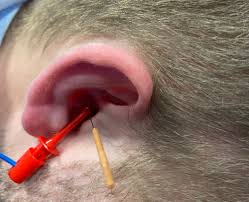In all of its manifestations, pain is a universal feeling. Whether it’s a sharp injury or the dull ache from a hard day’s work, our bodies are frequently in discomfort that can interfere with our day-to-day activities. While there are many different approaches and therapies available to reduce pain, dry needling is a little-known but incredibly powerful method. Though it looks like acupuncture, this method works on a different principle and is becoming more and more well-known for its capacity to provide long-lasting relief.
Knowing Your Dry Needling
In order to promote healing, dry needling entails inserting tiny needles into trigger points in the muscles, tendons, ligaments, or close to nerves. In contrast to acupuncture, which has its roots in traditional Chinese medicine and attempts to restore equilibrium in the body’s energy flow, dry needling targets particular trigger points in the muscles in order to reduce pain and enhance function.
The adjective “dry” in “dry needling” sets it apart from “wet” needling, which is injecting the body with anesthetics or saline. The only mechanical stimulation used in dry needling is that which the needle itself provides.
How Does It Operate?
Although research on the exact mechanism underlying the effectiveness of dry needling is still ongoing, a number of theories provide insight into its potential advantages. One explanation is that the body naturally produces neurotransmitters like serotonin and endorphins, which are pain-relieving chemicals, when needles are inserted into trigger points. This procedure facilitates muscle relaxation in the afflicted areas and lessens the perception of pain.
Furthermore, a localized twitch response may be triggered by the mechanical action of the needle being inserted into tense or knotted muscles. These twitches, which are caused by involuntary contractions of muscle fibers, are thought to aid in the healing process by reducing tension and enhancing local blood flow.
Furthermore, by specifically targeting trigger points, dry needling may break the cycle of pain and muscle dysfunction. These so-called “knots,” or trigger points, are extremely sensitive spots inside tense bands of muscle that can radiate pain to other parts of the body. Dry needling can stop pain signals and restore normal muscle function by deactivating these trigger points.
Conditions Dry Needling Treats
There is hope for the treatment of many musculoskeletal disorders, both acute and chronic, with dry needling. Typical ailments that could benefit from dry needling include the following:
1. Muscle Sprains and Strains: When muscles are strained or sprained as a result of overuse or injury, dry needling can help reduce pain and speed up the healing process.
2. Chronic Pain: As part of an all-encompassing treatment plan, dry needling may be an effective treatment for conditions like fibromyalgia, myofascial pain syndrome, and chronic lower back pain.
3. Sports Injuries: Repetitive strain injuries, trigger points, and muscle tightness are common among athletes. For the purpose of improving sports performance and averting more injuries, dry needling can help with pain relief and muscle function restoration.
4. Headaches and Migraines: Dry needling can help lessen the frequency and intensity of tension headaches and migraines by focusing on trigger points in the head, shoulders, and neck.
5. Joint Pain: By addressing muscular imbalances and reducing pain and stiffness around affected joints, dry needling can be used in addition to traditional treatments for conditions like rheumatoid arthritis and osteoarthritis.
Advantages of Needling
Dry needling’s capacity to deliver focused relief with few adverse effects is one of its main benefits. In contrast to drugs or invasive procedures, patients typically tolerate dry needling well and there is minimal chance of negative side effects. Furthermore, many people report immediate improvements in pain and mobility after a dry needling session, which makes it an effective tool for treating acute pain flare-ups.
Moreover, manual therapy, exercise, and physical therapy can all be incorporated into a thorough treatment plan that includes dry needling. Dry needling can assist patients in achieving long-term relief and enhancing their quality of life by treating both the symptoms and underlying causes of pain.
In Summary
Dry needling stands out in the field of pain management as a minimally invasive, safe, and effective way to treat musculoskeletal pain and dysfunction. Dry needling success stories provides long-lasting relief for many conditions, including chronic pain syndromes and sports injuries, by stimulating natural healing mechanisms and focusing on trigger points within the muscles.
Although more study is required to completely comprehend the mechanisms of action and ideal procedures for dry needling, the fact that it is becoming more and more popular with patients and healthcare professionals indicates that it has the potential to be an effective supplemental therapy for pain management. Incorporating dry needling into a multidisciplinary approach or as a stand-alone treatment, it can effectively penetrate the pain barrier and help individuals regain comfort and function.

